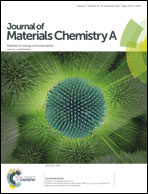Influence of mono versus bis-electron-donor ancillary ligands in heteroleptic Ru(ii) bipyridyl complexes on electron injection from the first excited singlet and triplet states in dye-sensitized solar cells†
Abstract
A novel heteroleptic Ru(II) bipyridyl complex (HD-1-mono) was molecularly designed with a mono-carbazole ancillary ligand, synthesized and characterized for DSCs. The aim was to systematically study the influence of mono (HD-1-mono) versus bis-carbazole ancillary ligand (NCSU-10) on molar absorptivity, light harvesting efficiency (LHE), ground and excited state oxidation potentials, incident-photon-to-current conversion efficiency (IPCE), electron injection from the first excited singlet and triplet states, short-circuit photocurrent density (Jsc), and total solar-to-electric conversion efficiency (η) for DSCs. This study showed that HD-1-mono exhibited slightly lower Voc but greater Jsc compared to NCSU-10. Though HD-1-mono showed lower extinction coefficient than NCSU-10, interestingly, it was found that the decrease in molar extinction coefficient of HD-1-mono is not directly related to the short-circuit photocurrent density (Jsc). For example, HD-1-mono showed a higher Jsc of 21.4 mA cm−2 without the presence of any additives. However, under optimized conditions, HD-1-mono showed a Jsc of 19.76 mA cm−2, Voc of 0.68 V, and (%η) of 9.33 compared to a Jsc of 19.58 mA cm−2, Voc of 0.71 and (%η) of 10.19 for NCSU-10, where N719 achieved a Jsc of 16.85 mA cm−2, Voc of 0.749 V and (%η) of 9.33 under the same experimental device conditions. Impedance results for HD-1-mono showed a shorter recombination time as compared to N719 and NCSU-10, which justify its lower Voc. Femtosecond transient absorption spectroscopy results elucidated that electron injection from the first triplet state is 63% more efficient for HD-1-mono than that of NCSU-10.


 Please wait while we load your content...
Please wait while we load your content...